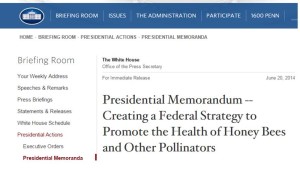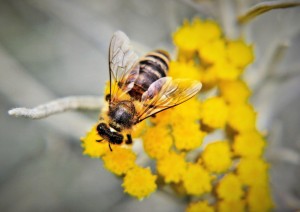Hello fellow readers, They say one out of every three bites of food depends on a pollinator. According to the Pollinator Partnership, the largest non-profit organization in the world dedicated to the protection of pollinators, the U.S. has lost over 50 percent of its managed honeybee colonies in the past ten years.
An Executive Strategy to protect pollinators
 It’s gotten national attention since the President declared an Executive Strategy to ‘Promote the Health of Honey Bees and Other Pollinators.’ His memorandum on the subject states, ‘there has been a significant loss of pollinators, including honey bees, native bees, birds, bats, and butterflies, from the environment. The problem is serious and requires immediate attention.’
It’s gotten national attention since the President declared an Executive Strategy to ‘Promote the Health of Honey Bees and Other Pollinators.’ His memorandum on the subject states, ‘there has been a significant loss of pollinators, including honey bees, native bees, birds, bats, and butterflies, from the environment. The problem is serious and requires immediate attention.’
There are a whopping 14 federal agencies on the task force with an objective to identify and hopefully remedy ‘different stressors leading to species declines and colony collapse disorder, including exposure to pesticides, poor nutrition, parasites, and other pests, toxins, loss of habitat and reduced natural forage, pathogens, and unsustainable management practices.’ Phew!
How to do our part to protect pollinators
It’s BIG and critically important that each of us does our part. Plant a pollinator-friendly garden using native or non-invasive annuals, perennials, and shrubs with a sequence of blooms, so nectar and pollen are available throughout the growing season. Include plants like dill, fennel, and milkweed that on which butterfly larvae feed. It’s essential to provide a water source such as a pond, fountain, or birdbath too.
Lay off the chemicals, even organic ones, as they also can be toxic to bees and other beneficial organisms. All things considered, though, an organic approach is safer when appropriately applied during times when pollinators are not active; in the early morning or late evening.
Add feeders to help attract hummingbirds and butterflies and provide shelter by letting a hedgerow or part of your lawn grow wild. Allow a dead tree to stay put, creating nooks for butterflies and solitary bees.
The National Pollinator Garden Network
One of the offshoots of the President’s initiative is the National Pollinator Garden Network (NPGN), a collaboration of national, regional, and local gardening clubs to help restore pollinator populations.
The elephant in the room – Imidacloprid
While it’s good news our government is on task to help our pollinators, it seems there’s the elephant in the room – Imidacloprid, the most widely used insecticide in the world. According to Wikipedia, research suggests that Imidacloprid’s widespread agricultural use may be contributing to honeybee colony collapse disorder, and the study that declared the chemical to be safe to our environment, animals, and humans may be flawed or even deceptive. Other countries have restricted its use. Sadly it seems we choose to keep our heads in the sand. How can it Bee?
Garden Dilemmas? AskMaryStone@gmail.com
Column updated 7/2/22
How you can avoid the deadly chemical:
Although Imidacloprid is now off-patent, the primary manufacturer is Bayer, though sold under many names for many uses. Look on product labels for neonicotinoids or Imidacloprid, and if found, stay clear:
- Used for pest control in agriculture.
- It is injected into foundations to prevent termite damage.
- It’s in pest controls for gardens and lawns.
- And as protection of trees from boring insects.
- Neonicotinoids or Imidacloprid serve as a preservative on some types of lumber products.
- And as a topical treatment on pets to control fleas.



